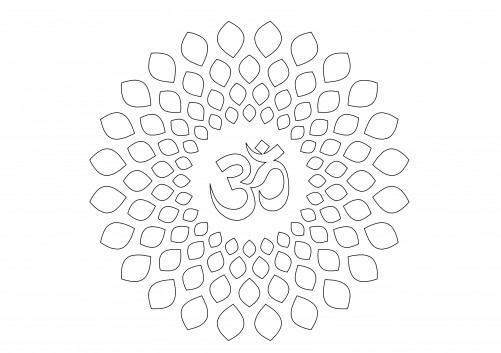
DOWNLOAD
Symbols
A Hindu temple, commonly referred to as a Mandir or Devasthana, is a symbolic house, seat and body of divinity for Hindus. It is a structure designed to bring human beings and gods together, using symbolism to express the ideas and beliefs of Hinduism. The symbolism and structure of a Hindu temple are rooted in Vedic traditions, deploying circles and squares. It also represents recursion and equivalence of the macrocosm and the microcosm by astronomical numbers, and by "specific alignments related to the geography of the place and the presumed linkages of the deity and the patron". A temple incorporates all elements of Hindu cosmos—presenting the good, the evil and the human, as well as the elements of Hindu sense of cyclic time and the essence of life—symbolically presenting dharma, kama, artha, moksa, and karma. The spiritual principles symbolically represented in Hindu temples are given in the ancient Sanskrit texts of India (for example, Vedas and Upanishads), while their structural rules are described in various ancient Sanskrit treatises on architecture (Brhat Samhita, Vastu Sastras). The layout, the motifs, the plan and the building process recite ancient rituals, geometric symbolisms, and reflect beliefs and values innate within various schools of Hinduism. A Hindu temple is a spiritual destination for many Hindus, as well as landmarks around which ancient arts, community celebrations and economy have flourished. Hindu temples come in many styles, are situated in diverse locations, deploy different construction methods and are adapted to different deities and regional beliefs, yet almost all of them share certain core ideas, symbolism and themes. They are found in South Asia particularly India and Nepal, Pakistan, in southeast Asian countries such as Sri Lanka, Cambodia, Vietnam, and islands of Indonesia and Malaysia, and countries such as Canada, Fiji, France, Guyana, Kenya, Mauritius, the Netherlands, South Africa, Suriname, Tanzania, Trinidad and Tobago, Uganda, the United Kingdom, the United States, and other countries with a significant Hindu population. The current state and outer appearance of Hindu temples reflect arts, materials and designs as they evolved over two millennia; they also reflect the effect of conflicts between Hinduism and Islam since the 12th century. The Swaminarayanan Akshardham in Robbinsville, New Jersey, United States, between the New York and Philadelphia metropolitan areas, was inaugurated in 2014 as one of the world's largest Hindu temples. You need more Symbols DWG and AutoCAD Blocks and Drawings? Check the Symbols Category. Access our entire CAD blocks and DWG drawings on our homepage. For free 3D files, visit Freepolygon. Need free vector illustrations? Check out Vectorfreefiles. Stay updated with the latest design news and insights at Designrecap. Explore a global directory of design professionals and firms at Meshegg. Explore more resources for architecture students and professionals at Archiskills.
Tags:
abstract , decor , hindu , temple , mandir , cnc , design , pattern , symbol , art , symbolic
FROM THIS CATEGORY
4401
FREE FILES
FOR DOWNLOADING
We’ll design for you new CAD blocks, for free!
Because at Freecads, we’ve built a world that works,
just the way it should!